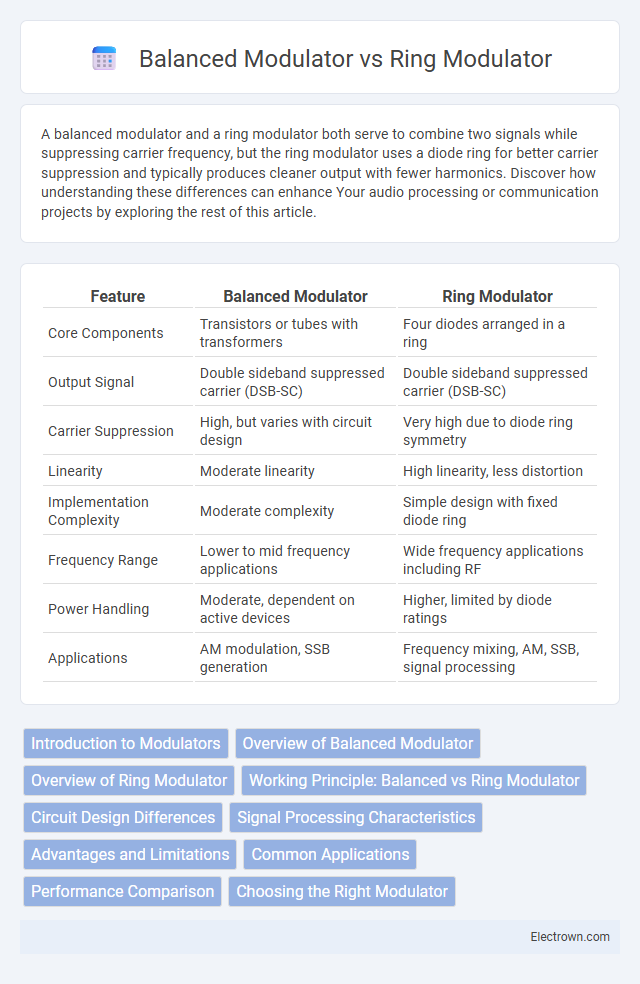A balanced modulator and a ring modulator both serve to combine two signals while suppressing carrier frequency, but the ring modulator uses a diode ring for better carrier suppression and typically produces cleaner output with fewer harmonics. Discover how understanding these differences can enhance Your audio processing or communication projects by exploring the rest of this article.
Table of Comparison
| Feature | Balanced Modulator | Ring Modulator |
|---|---|---|
| Core Components | Transistors or tubes with transformers | Four diodes arranged in a ring |
| Output Signal | Double sideband suppressed carrier (DSB-SC) | Double sideband suppressed carrier (DSB-SC) |
| Carrier Suppression | High, but varies with circuit design | Very high due to diode ring symmetry |
| Linearity | Moderate linearity | High linearity, less distortion |
| Implementation Complexity | Moderate complexity | Simple design with fixed diode ring |
| Frequency Range | Lower to mid frequency applications | Wide frequency applications including RF |
| Power Handling | Moderate, dependent on active devices | Higher, limited by diode ratings |
| Applications | AM modulation, SSB generation | Frequency mixing, AM, SSB, signal processing |
Introduction to Modulators
Balanced modulators and ring modulators are essential components in electronic communication systems, designed to multiply two input signals to produce an output containing sum and difference frequencies. Balanced modulators suppress the carrier signal, facilitating double sideband suppressed carrier (DSB-SC) modulation commonly used in AM transmitters. Ring modulators utilize a diode ring configuration to achieve high carrier suppression with improved linearity and isolation, making them ideal for applications like frequency mixing and generating single sideband signals.
Overview of Balanced Modulator
A Balanced Modulator is an electronic circuit designed to multiply two input signals, producing an output that contains only the sum and difference frequencies while suppressing the original carrier signal. It is commonly used in amplitude modulation (AM) and single sideband (SSB) applications for efficient signal processing. Your choice of a Balanced Modulator ensures reduced carrier interference and improved modulation quality compared to simpler modulation techniques.
Overview of Ring Modulator
Ring modulators utilize four diodes arranged in a ring configuration to achieve amplitude modulation by multiplying two input signals, typically a carrier and a modulating signal. This configuration produces sum and difference frequencies while suppressing the original signals, making ring modulators essential in applications like musical effects and communications for generating complex tones and frequency shifts. Their ability to maintain high linearity and low distortion distinguishes ring modulators from balanced modulators, which use transformers or differential amplifier circuits for signal mixing.
Working Principle: Balanced vs Ring Modulator
The working principle of a balanced modulator relies on using two active devices arranged to suppress the carrier signal, allowing only the product of the two input signals (modulating and carrier) to pass through, resulting in double sideband suppressed carrier (DSB-SC) output. In contrast, a ring modulator employs a ring of diodes or transistors arranged in a bridge circuit, which achieves carrier suppression through diode conduction states, producing a highly linear multiplication of input signals and resulting in the same DSB-SC output. Understanding these differences helps you choose the appropriate modulator based on linearity requirements and circuit complexity.
Circuit Design Differences
Balanced modulators use two balanced mixers with transformers or differential amplifiers to suppress the carrier signal, while ring modulators employ a diode ring configuration for carrier suppression and simpler circuitry. You will find that balanced modulators offer better linearity and isolation between ports, but ring modulators provide more compact design and easier implementation. The choice depends on the trade-off between complexity and performance in your modulation application.
Signal Processing Characteristics
Balanced modulators suppress the carrier frequency, producing double sideband suppressed carrier (DSB-SC) signals ideal for efficient amplitude modulation without carrier interference. Ring modulators use a diode ring to achieve high carrier suppression and better linearity, resulting in cleaner signal output with reduced distortion. Both modulators are essential in signal processing for generating DSB-SC signals but differ in complexity and harmonic distortion levels.
Advantages and Limitations
Balanced modulators offer precise carrier suppression and lower distortion, making them ideal for generating double-sideband suppressed-carrier signals in communication systems. Ring modulators provide superior carrier suppression and high linearity, but their design complexity and sensitivity to component matching can limit practical implementation. Both modulators play crucial roles in RF signal processing, with balanced modulators favored for simpler circuits and ring modulators preferred for high-performance applications.
Common Applications
Balanced modulators are widely used in single-sideband (SSB) and double-sideband suppressed carrier (DSB-SC) transmission systems due to their ability to suppress the carrier signal and produce clean sidebands. Ring modulators find common applications in audio signal processing, such as generating vocal effects or frequency mixing, because of their high linearity and low distortion characteristics. Both modulators play critical roles in communication systems, but balanced modulators are favored for reducing spectral interference, while ring modulators excel in precise frequency conversion tasks.
Performance Comparison
Balanced modulators offer improved linearity and lower distortion compared to ring modulators, making them suitable for high-fidelity signal processing. Ring modulators typically provide better carrier suppression and simpler circuitry but may introduce more harmonic distortion and noise. Your choice depends on whether you prioritize signal clarity or circuit simplicity in performance-critical applications.
Choosing the Right Modulator
Choosing the right modulator depends on the specific application requirements such as signal purity, complexity, and cost. Balanced modulators offer simpler design and reduced carrier leakage, making them suitable for basic amplitude modulation and suppressed carrier applications. Ring modulators provide better carrier suppression and higher linearity, ideal for professional audio processing and complex signal modulation tasks.
Balanced Modulator vs Ring Modulator Infographic

 electrown.com
electrown.com